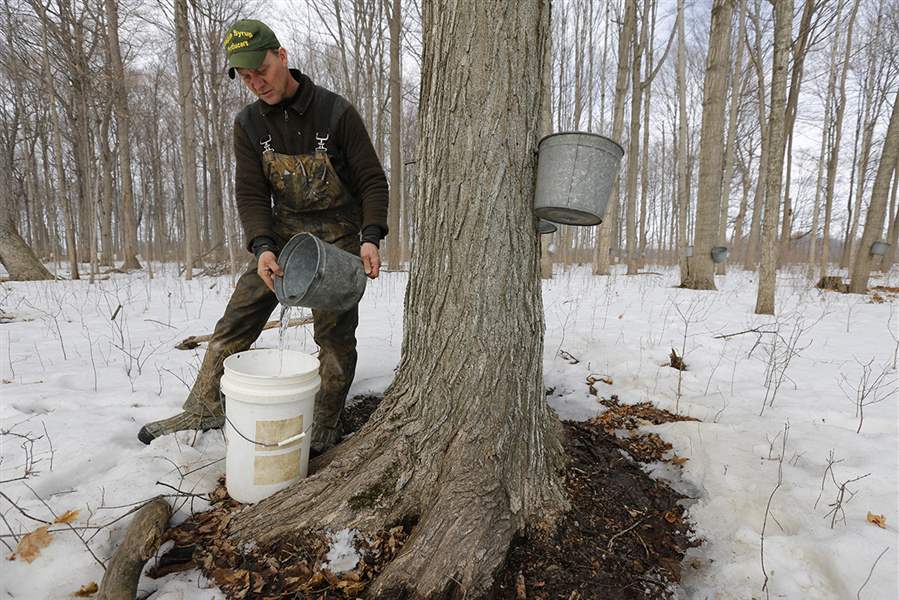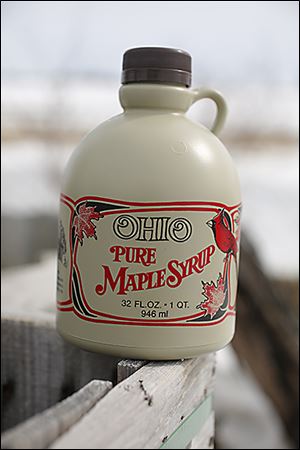
SWEET SIGN OF WINTER’S END
True maple syrup rooted in tradition for one area family
3/13/2014
Jeff Dick empties sap from a tin bucket at Dick’s Maple Farm near Montpelier, Ohio.
THE BLADE/ANDY MORRISON
Buy This Image

Jeff Dick empties sap from a tin bucket at Dick’s Maple Farm near Montpelier, Ohio.
MONTPELIER, Ohio — Back in the woods, near miles of tubing or hundreds of vintage buckets, seasonal sweet spots simmer with here-comes-spring flavor.
As steam shrouds sugar shacks, wisps of folklore float skyward. Golden strands of tradition link maple producers to the land, to their ancestors.
You won’t find true maple-syrup producers anywhere in the world except right here in North America, such as in Ohio, Michigan, and a few other states, plus of course Canadian provinces.
Real maple syrup needs real maple sap. It’s said, by experts in the world of sugar shacks and sugar bushes, that you can grow a maple most anywhere. But weather is key to sap gathering for production of the syrup.
Ah, the weather this year. Enough to bring a sigh, a shrug from Jeff Dick earlier this week.
Maple production for 2014 is iffy because of the long-lasting freezer blast in February. Trees normally tapped in mid-February were tapped in recent days. “Usually by the first of March we’re making syrup,” he said.
As this week’s winter storm approached, Mr. Dick, field specialist for Ohio State University Extension in Fulton County, was eager to begin the first boil of the season now that sap is finally running.
Pressure inside trees pushes sap upward and then back down with temperature change, said Mr. Dick. “You want 20-degree nights and 40-degree days.”

Dick’s Maple Farm is just beginning syrup production.
The maple season might run five or six weeks this year, Mr. Dick predicted. “We are starting late. You want to get sap for a long time.”
He welcomes a season similar to last year. He cringes at thoughts of 2012.
“Last year was the best ever in history. In 2012, February warmed up and stayed warm. It was one of the worst years ever,” he said.
Making syrup is a family tradition, said Mr. Dick, 46, who, along with his brother Lamar, 61, and their father Dallas, 83, operates Dick’s Maple Farm near Montpelier.
Nationally, maple syrup production totaled 3.25 million gallons last year, up 70 percent from 2012.
Demand for the natural product is growing.
“We’re hearing more about the antioxidants and other health benefits of maple syrup,” said Anne Marie Michaels, the administrative assistant at the Williams Soil & Water Conservation District, one of the sponsors of an annual maple syrup festival in Montpelier.
Highlighted by horse-drawn wagon rides to a sugar shack on the Williams County Fairgrounds, the event usually draws more than 1,600 people, said Mr. Dick who takes part in the event.
As part of the rural renaissance, more people are trying, and liking, locally made maple syrup. Homemade. Homegrown. Drizzled on ice cream. Baked in cookies. Swirled in smoothies. It’s a sort of trip-back-in-time taste.
Glance around one of the Dick family’s sap-producing areas. Years seem to melt away faster than snow on a 50-degree day.
Tin buckets, by the hundreds, dot waists of maple trees. An old sugar shack, a ghost of its former golden glory, adds to the nostalgia.
Next week, area students will take part in a maple syrup field trip to the Williams County Fairgrounds, where Mr. Dick tends the evaporator and quizzes the kids. What, he asks, is the boiling point of water? Hands — “Pick me, I know the answer” — shoot into the air. And the answers come: “212 degrees.”
“That’s what they are taught. But that is water that boils at sea level. We are not at sea level. We are at about 550 feet here,” he said, showing a smidge of the science involved in turning the lifeblood of a tree into something people pour on pancakes.
Locally, water boils at 211.4 degrees. Sap boils at a higher temperature. A skilled eye and specialized equipment track temperature and density during the evaporation process. Other steps include sterilizing, filtering, grading, and packing each gallon of syrup.
Products commonly called “maple syrup” trigger tsk-tsk from some producers. They scoff at flavored corn syrup, referring to it as “pole syrup,” meaning it tastes as though someone tapped a utility pole rather than a maple tree.
Contact Janet Romaker at: jromaker@theblade.com or 419-724-6006.